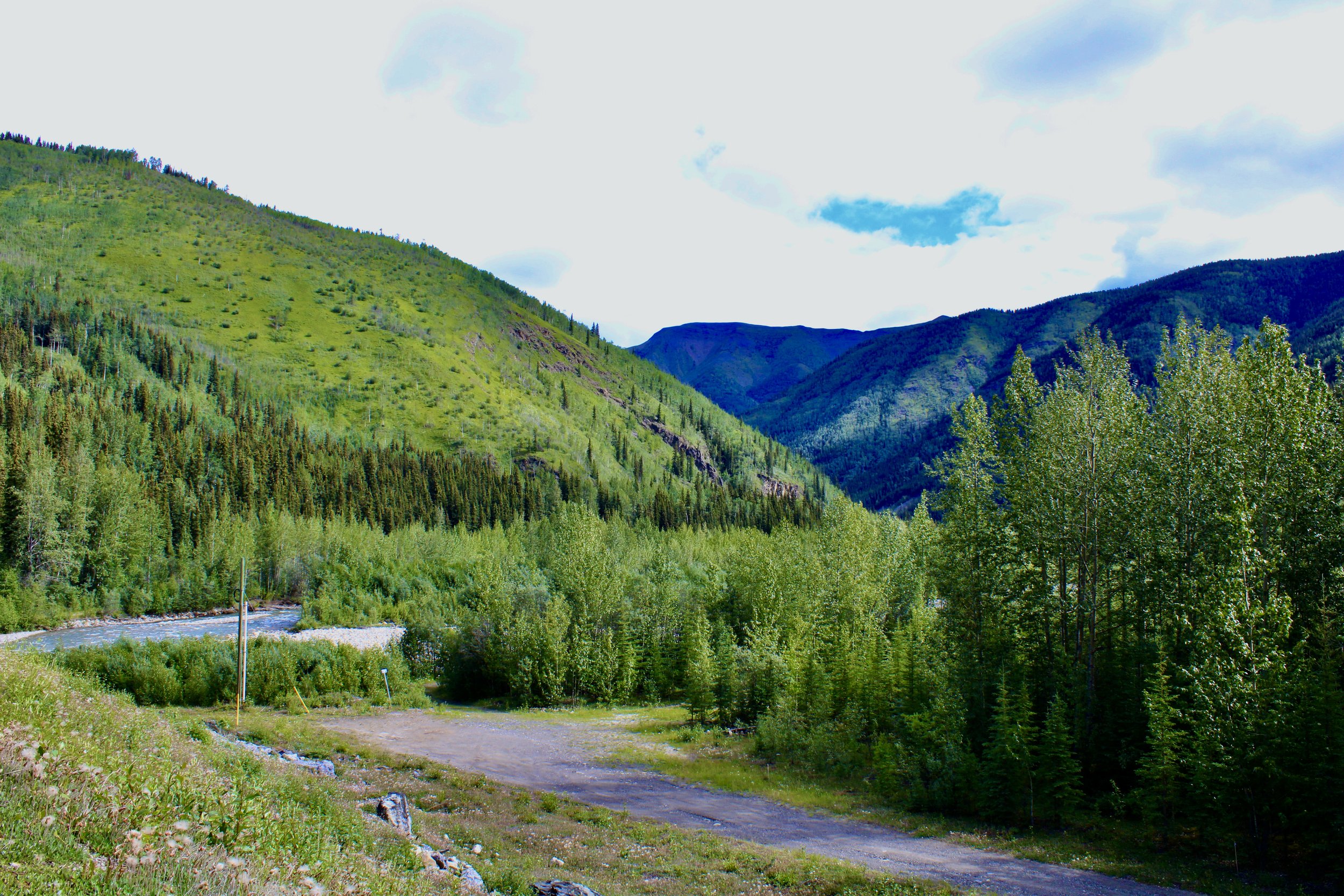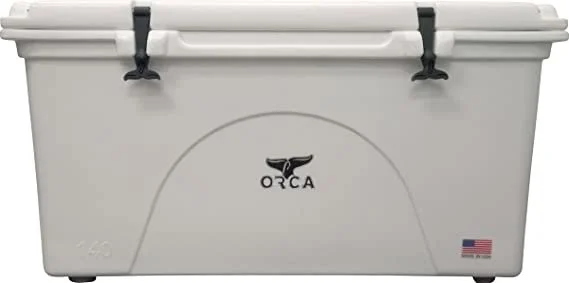Alcan Essentials
A comprehensive list of the things you need to survive the Alaskan/Canadian Highway
I may earn a small commission on sales from links.
One of the many beautiful roadside stops along the way.The Alcan (or Alaskan/Canadian Highway) is the main path connecting Montana to Alaska. I recently made this drive because I took a travel contract in Alaska. If you want to learn more about the actual drive, you can click here to read about the journey. This post is all about the things my husband and I made sure to bring with us to ensure we made the 4,500-mile voyage safely. The trip to Alaska is long and can be treacherous. As you get closer to Alaska, the towns become few and far between. You will need some extras to make sure you get to your destination on time.
Our Tahoe loaded up and ready to head to Alaska!Reliable vehicle
This tip may seem like a no brainer, but it still needs to be said. A reliable vehicle is not only going to help you get to your destination safely, but will also reduce the need to fix your vehicle while you are there. The trip from Michigan was over 4,500 miles. I can tell you, a reliable vehicle was 100% responsible for getting us to Alaska safely. I would suggest getting your vehicle inspected and serviced before you depart, even if it is newer vehicle. Ours is fairly new, however upon inspection from a professional, we found some unanticipated leaks and failures that were replaced under our service warrantee free of charge. Also, while reliability is important, your comfort is paramount. I recommend stopping every 200 miles or so and stretching your legs. Your back and legs will thank you for it.
A Good Cooler
Road trip snacks are the best, but warm root beer is not. The best option for drinks and food that need to be kept cold in your vehicle, is a well-insulated cooler. My husband will tell you that you need a massive cooler. My advice is to get a cooler that will hold at least a week’s worth of snacks, drinks, and food. We got an Orca cooler (like this) because it had a large amount of storage space and it is well insulated. Regardless of brand, make sure you don’t forget that ice also needs to fit in order to keep your food and drinks cold. There are not many places to get food along the way that isn’t insanely expensive. We ended up bringing food over the border with us and stopped at a grocery store in Calgary.
This is what the M+S rating on our tire looks like. The tires you currently have on your vehicle could work depending on their rating.New tires (optional, but highly recommended)
British Columbia has a bunch of steep inclines and declines. While this makes for a drive with beautiful vistas, it also makes for treacherous roads in the winter time. To address this, British Columbia requires all vehicles to have snow tires, studded tires, or M+S designated tires from October 1st to April 30th. Regardless of what time of year you make the drive, new tires are a great idea. I can’t even begin to count the number of people we saw along the side of the road changing out tires. Seeing them stopped really confirmed in my mind that we made the right choice.
Tire repair kit(s)/air compressor
Along the same lines as new tires, a tire repair kit is a fantastic idea. Parts of the road are pretty rough (I’m looking at you, Yukon). If you are driving all the way to Alaska, be prepared for potholes and uneven roads once you leave British Columbia. A tire repair kit (like this one) will help you get back on the road quickly. You will also need an air compressor (like this one) to refill your tire after the tire is fixed. I highly recommend a compressor that will run off the auxiliary plug, especially if you don’t have a wall plug in your vehicle. We made the drive in four extremely long days, which meant delays would put us quite a bit behind. Thankfully, we didn’t need to use our repair kit and air compressor.
Car extras (gas, oil, antifreeze, etc.)
When you are putting a large number of miles on your vehicle in one go, it is important to ensure peak performance. We made the executive decision to get the vehicle serviced before we left, but we also wanted to make sure we had backups of common car fluids available if something happened along the way. We had extra oil, a half a tank worth of gas (ten gallons), antifreeze, shovels, windshield wiper fluid, and even extra windshield wipers. It can really damage your vehicle to be without most of these fluids for very long, so being able to top off or replace them can help you get to the next stopping point. Hopefully one where you can get the issue fixed. If you’re thinking, “I doubt I need extra windshield wiper fluid, how vital can that be?” I can tell you that the amount of bugs plastering your windshield and the front of your car as you drive through most of Canada is simply staggering. On top of using a lot of fluid, we had to clean the windshield regularly at gas stations. The drive is gorgeous, give yourself the ability to see it without looking through smashed bugs.
Another stunning view along the Alcan.Some Canadian cash
It may not seem like a big deal, but all those international fees can add up quickly. Bringing some cash along will help if you need to buy ice for the cooler or you are tired of sandwiches for lunch and dinner. You may also want to stop at a museum or road side attraction along the way to stretch your legs. These things are easier on the wallet when you don’t have to pay fees on top of the cost of your entertainment.
Satellite communicator and/or GPS
Even if your cell phone works in Canada, you WILL lose service during a lot of the trip. We did some research into the best device for our needs and ended up deciding on the Garmin Montana 750i. You can buy one here. The Montana 750i worked really well as a driving GPS though this is not its primary function. It even quickly recalculated our route when we made some unplanned stops. It made us feel really safe because not only does it have GPS, but it also has an SOS button to use in case of emergencies. For my paramedic-husband’s peace of mind, we needed the ability to call for help if we became stranded or had a medical emergency while we were without cell service. You may not be able to afford the one that we bought, but I highly recommend purchasing some sort of satellite communication device. We saw a ton of wildlife, and I don’t want you to be attacked by a bear and left in the middle of British Columbia without a way of getting help. The 750i isn’t limited to just driving however, it is designed to be a great GPS for hiking, biking, dirt bike/motorcycle rides over unnamed trails, or for those who forge their own path. It will even show the path you’ve tread, and give you an exact route back to where you started. It is also capable of using apps that crowdsource peoples favorite hikes in your area. It is preprogramed with North American maps. For additional maps, or maps of other areas outside of North America, you will have to purchase them separately and upload them into the 750i via a sim card slot that sits behind the battery.
The sign on the Alaskan/Canadian boarder welcoming people to Alaska.Paperwork for border crossings (enhanced driver’s license or passport)
Of course, the Alcan takes you across another country. Make sure you have all your travel documents lined up and ready to go. I assembled ours into an expandable file folder like this one to keep everything organized and in one easy to access location. Don’t forget to download the ArriveCAN app so that you can cross into Canada. It’s easy to sign up, and it compiles all the information (including vaccine status, COVID test results, and passport information) the Canadian Border guards need to get you across the border quickly. It was very easy to use and at the time of writing this, needs to be completed within 72 hours of your arrival into Canada.
First aid kit
No one wants to think about getting hurt. With my husband and I both being in the medical field, we can assure you accidents do happen. You personally may not be the type of person to get out of your vehicle to photograph a grizzly bear six feet away from the front bumper of your truck (seriously, we watched this happen on our way to Alaska), but car crashes, knife slips, and kids throwing rocks at each other happen to everyone. Keep yourself and those you love in one piece by purchasing a comprehensive first aid kit. I recommend one like this or like this. My paramedic-husband wasn’t happy with a simple kit, so he took it upon himself to assemble one by purchasing bandages and supplies individually, and including and excluding what he thought we needed. His kit was complete with Israeli bandages, clotting agents, and tourniquets. You can click the links here, here, and here to see what special items he included in our kit.
A beautiful mountain vista once you get south of Tok, Alaska.I can honestly say, the Alcan is one of the longest, most beautiful drives I have EVER taken. If you are taking the trip with a camper/RV and intend on touring around Alaska, I highly recommend taking your time. There were so many beautiful stops to make along the way. As a reminder, you can read about the drive from Michigan to Alaska by clicking here. If you want to know how to become a traveler like I am, click here to go to my post about getting started. I look forward to more adventures I can take you guys on!
Happy traveling!
Kat










